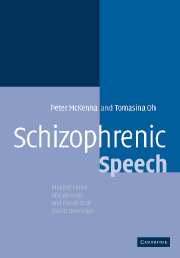34 results
Do the negative symptoms of schizophrenia reflect reduced responsiveness to reward? Examination using a reward prediction error (RPE) task
-
- Journal:
- Psychological Medicine / Volume 53 / Issue 15 / November 2023
- Published online by Cambridge University Press:
- 29 March 2023, pp. 7106-7115
-
- Article
-
- You have access
- Open access
- HTML
- Export citation
Neural correlates of referential/persecutory delusions in schizophrenia: examination using fMRI and a virtual reality underground travel paradigm
-
- Journal:
- Psychological Medicine / Volume 53 / Issue 10 / July 2023
- Published online by Cambridge University Press:
- 22 June 2022, pp. 4780-4787
-
- Article
- Export citation
Preserving last resort antibiotics: A meropenem reduction strategy
-
- Journal:
- Infection Control & Hospital Epidemiology / Volume 43 / Issue 10 / October 2022
- Published online by Cambridge University Press:
- 12 July 2021, pp. 1516-1517
- Print publication:
- October 2022
-
- Article
-
- You have access
- HTML
- Export citation
A history of high-power laser research and development in the United Kingdom
- Part of
-
- Journal:
- High Power Laser Science and Engineering / Volume 9 / 2021
- Published online by Cambridge University Press:
- 27 April 2021, e18
-
- Article
-
- You have access
- Open access
- HTML
- Export citation
Autobiographical memory and default mode network function in schizophrenia: an fMRI study—CORRIGENDUM
-
- Journal:
- Psychological Medicine / Volume 51 / Issue 1 / January 2021
- Published online by Cambridge University Press:
- 07 May 2020, p. 129
-
- Article
-
- You have access
- Open access
- HTML
- Export citation
Autobiographical memory and default mode network function in schizophrenia: an fMRI study
-
- Journal:
- Psychological Medicine / Volume 51 / Issue 1 / January 2021
- Published online by Cambridge University Press:
- 04 November 2019, pp. 121-128
-
- Article
-
- You have access
- Open access
- HTML
- Export citation
Evidence for default mode network dysfunction in borderline personality disorder
-
- Journal:
- Psychological Medicine / Volume 50 / Issue 10 / July 2020
- Published online by Cambridge University Press:
- 28 August 2019, pp. 1746-1754
-
- Article
- Export citation
Towards Atomic Resolution Electron Microscopy with Structured Temporal Electron Illumination of Picosecond Time Resolution
-
- Journal:
- Microscopy and Microanalysis / Volume 25 / Issue S2 / August 2019
- Published online by Cambridge University Press:
- 05 August 2019, pp. 1652-1653
- Print publication:
- August 2019
-
- Article
-
- You have access
- Export citation
Structural and functional brain changes in delusional disorder
-
- Journal:
- The British Journal of Psychiatry / Volume 208 / Issue 2 / February 2016
- Published online by Cambridge University Press:
- 02 January 2018, pp. 153-159
- Print publication:
- February 2016
-
- Article
-
- You have access
- HTML
- Export citation
Brain functional changes across the different phases of bipolar disorder
-
- Journal:
- The British Journal of Psychiatry / Volume 206 / Issue 2 / February 2015
- Published online by Cambridge University Press:
- 02 January 2018, pp. 136-144
- Print publication:
- February 2015
-
- Article
-
- You have access
- HTML
- Export citation
Contributors
-
-
- Book:
- Intellectual Property and the Common Law
- Published online:
- 05 September 2013
- Print publication:
- 02 September 2013, pp ix-x
-
- Chapter
- Export citation
Structural brain changes associated with tardive dyskinesia in schizophrenia
-
- Journal:
- The British Journal of Psychiatry / Volume 203 / Issue 1 / July 2013
- Published online by Cambridge University Press:
- 02 January 2018, pp. 51-57
- Print publication:
- July 2013
-
- Article
-
- You have access
- HTML
- Export citation
Contributors
-
-
- Book:
- Sleep Deprivation, Stimulant Medications, and Cognition
- Published online:
- 05 September 2012
- Print publication:
- 23 August 2012, pp vii-viii
-
- Chapter
- Export citation
Neural correlates of cognitive impairment in schizophrenia
-
- Journal:
- The British Journal of Psychiatry / Volume 199 / Issue 3 / September 2011
- Published online by Cambridge University Press:
- 02 January 2018, pp. 202-210
- Print publication:
- September 2011
-
- Article
-
- You have access
- HTML
- Export citation
Contributors
-
-
- Book:
- Essential Clinical Anesthesia
- Published online:
- 05 January 2012
- Print publication:
- 11 July 2011, pp xv-xxviii
-
- Chapter
- Export citation
Levels of explanation – symptoms, neuropsychological deficit and morphological abnormalities in schizophrenia1
-
- Journal:
- Psychological Medicine / Volume 24 / Issue 3 / August 1994
- Published online by Cambridge University Press:
- 09 July 2009, pp. 541-545
-
- Article
-
- You have access
- Export citation
8 - Some conclusions and a few speculations
-
- Book:
- Schizophrenic Speech
- Published online:
- 19 August 2009
- Print publication:
- 17 February 2005, pp 172-185
-
- Chapter
- Export citation
Frontmatter
-
- Book:
- Schizophrenic Speech
- Published online:
- 19 August 2009
- Print publication:
- 17 February 2005, pp i-vi
-
- Chapter
- Export citation
1 - Describing schizophrenic speech
-
- Book:
- Schizophrenic Speech
- Published online:
- 19 August 2009
- Print publication:
- 17 February 2005, pp 1-25
-
- Chapter
- Export citation

Schizophrenic Speech
- Making Sense of Bathroots and Ponds that Fall in Doorways
-
- Published online:
- 19 August 2009
- Print publication:
- 17 February 2005



